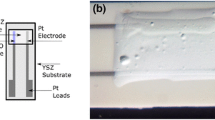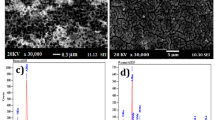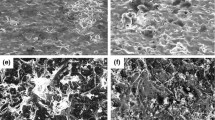Abstract
We report the design and scalable fabrication of a low-cost and low-power polyaniline-based (PANI) ammonia (NH3) gas sensor on polyimide (PI) substrates using additive manufacturing techniques. The silver interdigitated electrode (IDE) arrays and conducting polymer films are printed onto PI using a direct-write technology of aerosol-jet printing. Morphological characteristics are examined by scanning electron microscopy and energy-dispersive X-ray analysis which reveal homogeneously printed PANI film on the IDE platform. The gas sensing performance is evaluated in the analytical early leak detection range of 5–1000 ppm NH3 in air as a function of both thermal (23 °C, 50 °C, 80 °C) and relative humidity (RH = 0%, 30%, 50%) exposures. The sensor exhibits sensitivity down to 5 ppm NH3 with a sub-ppm detection limit and good repeatability. We observe rapid NH3 detection at 0% RH with very extended times for equilibration and recovery. However, at both 30 and 50% RH, the room temperature response and recovery times are reduced to only about 1 min and 5 min, respectively. Experiments also reveal good sensitivity toward the analyte even at higher operating temperatures. Present results merit the practical application of aerosol-jet-printed, low-power sensors for industrial applications where low-level hazardous gas detection is essential.
Graphical Abstract









Similar content being viewed by others
Explore related subjects
Discover the latest articles and news from researchers in related subjects, suggested using machine learning.References
Stratospheric Ozone Protection. U.S. Code, § 7671. Title 42, 2000.
United States Environmental Protection Agency. Phaseout of Class II Ozone-Depleting Substances https://www.epa.gov/ods-phaseout/phaseout-class-ii-ozone-depleting-substances.
Francis C, Maidment G, Davies G (2017) An investigation of refrigerant leakage in commercial refrigeration. Int J Refrig 74:12–21. https://doi.org/10.1016/j.ijrefrig.2016.10.009
Koronaki IP, Cowan D, Maidment G, Beerman K, Schreurs M, Kaar K, Chaer I, Gontarz G, Christodoulaki RI, Cazauran X (2012) Refrigerant emissions and leakage prevention across Europe – results from the realskillseurope project. Energy 45(1):71–80. https://doi.org/10.1016/j.energy.2012.05.040
Beshr M, Aute V, Sharma V, Abdelaziz O, Fricke B, Radermacher R (2015) A comparative study on the environmental impact of supermarket refrigeration systems using low GWP refrigerants. Int J Refrig 56:154–164. https://doi.org/10.1016/j.ijrefrig.2015.03.025
Joshi, P. Peel and Stick Sensor for Refrigerant Leak Detection https://www.energy.gov/sites/prod/files/2019/05/f62/bto-peer-2019-ornl-peel-stick-sensor-refrig-leak-det.pdf.
Pearson A (2008) Refrigeration with ammonia. Int J Refrig 31(4):545–551. https://doi.org/10.1016/j.ijrefrig.2007.11.011
Harby K (2017) Hydrocarbons and their mixtures as alternatives to environmental unfriendly halogenated refrigerants: an updated overview. Renew Sustain Energy Rev 73:1247–1264. https://doi.org/10.1016/j.rser.2017.02.039
Daniel, J. S.; Velders , G. J. M. Halocarbon Scenarios, Ozone Depletion Potentials, and Global Warming Potentials. In Scientific Assessment of Zzone Depletion: 2006; Global Ozone Research and Monitoring Project; World Meteorological Organization: Geneva, Switzerland, 2007; Vol. 50, pp 8.1–8.39.
Pandey S (2016) Highly sensitive and selective chemiresistor gas/vapor sensors based on polyaniline nanocomposite: a comprehensive review. J Sci Adv Mater Devices 1(4):431–453. https://doi.org/10.1016/j.jsamd.2016.10.005
Tanguy NR, Thompson M, Yan N (2018) A review on advances in application of polyaniline for ammonia detection. Sens Actuators B Chem 257:1044–1064. https://doi.org/10.1016/j.snb.2017.11.008
Fratoddi I, Venditti I, Cametti C, Russo MV (2015) Chemiresistive polyaniline-based gas sensors: a mini review. Sens Actuators B Chem 220:534–548. https://doi.org/10.1016/j.snb.2015.05.107
Molapo KM, Ndangili PM, Ajayi RF, Mbambisa G, Mailu SM, Njomo N, Masikini M, Baker P, Iwuoha EI (2012) Electronics of conjugated polymers (I): polyaniline. Int J Electrochem Sci 7:11859–11875
Liao G, Li Q, Xu Z (2019) The chemical modification of polyaniline with enhanced properties: a review. Prog Org Coat 126:35–43. https://doi.org/10.1016/j.porgcoat.2018.10.018
Crowley K, Morrin A, Hernandez A, O’Malley E, Whitten PG, Wallace GG, Smyth MR, Killard AJ (2008) Fabrication of an ammonia gas sensor using inkjet-printed polyaniline nanoparticles. Talanta 77(2):710–717. https://doi.org/10.1016/j.talanta.2008.07.022
Rizzo G, Arena A, Donato N, Latino M, Saitta G, Bonavita A, Neri G (2010) Flexible, all-organic ammonia sensor based on dodecylbenzene sulfonic acid-doped polyaniline films. Thin Solid Films 518(23):7133–7137. https://doi.org/10.1016/j.tsf.2010.07.016
Crowley K, O’Malley E, Morrin A, Smyth MR, Killard AJ (2008) An Aqueous ammonia sensor based on an inkjet-printed polyaniline nanoparticle-modified electrode. Analyst 133(3):391–399. https://doi.org/10.1039/B716154A
Huang Q, Zhu Y (2019) Printing Conductive Nanomaterials for Flexible and Stretchable Electronics: A Review of Materials, Processes, and Applications. Adv Mater Technol 4(5):1800546. https://doi.org/10.1002/admt.201800546
Kuswandi B, Jayus M, Restyana A, Abdullah A, Heng LY, Ahmad MA (2012) Novel colorimetric food package label for fish spoilage based on polyaniline film. Food Control 25(1):184–189. https://doi.org/10.1016/j.foodcont.2011.10.008
Le Maout P, Wojkiewicz JL, Redon N, Lahuec C, Seguin F, Dupont L, Mikhaylov S, Noskov Y, Ogurtsov N, Pud A (2018) Polyaniline nanocomposites based sensor array for breath ammonia analysis. Portable e-Nose approach to non-invasive diagnosis of chronic kidney disease. Sens Actuators B Chem 274:616–626. https://doi.org/10.1016/j.snb.2018.07.178
Haynes, A.; Gouma, P.-I. Polyaniline-Based Environmental Gas Sensors. In Sensors for Environment, Health and Security; Baraton, M.I., Ed.; NATO Science for Peace and Security Series C: Environmental Security; Springer Netherlands: Dordrecht, 2009; pp 451–459. https://doi.org/https://doi.org/10.1007/978-1-4020-9009-7_30.
Moulton SE, Innis PC, Kane-Maguire LAP, Ngamna O, Wallace GG (2004) Polymerisation and characterisation of conducting polyaniline nanoparticle dispersions. Curr Appl Phys 4(2):402–406. https://doi.org/10.1016/j.cap.2003.11.059
Ngamna O, Morrin A, Killard AJ, Moulton SE, Smyth MR, Wallace GG (2007) Inkjet printable polyaniline nanoformulations. Langmuir ACS J Surf Colloids 23(16):8569–8574. https://doi.org/10.1021/la700540g
Huang, J.; Kaner, R. B. Polyaniline nanofibers: Syntheses, properties, and applications. In Conjugated Polymers: Theory, Synthesis, Properties, and Characterization; CRC Press: Boca Raton, FL, 2007; Vol. 1, pp 7.1–7.49.
Deshpande NG, Gudage YG, Sharma R, Vyas JC, Kim JB, Lee YP (2009) Studies on tin oxide-intercalated polyaniline nanocomposite for ammonia gas sensing applications. Sens Actuators B Chem 138(1):76–84. https://doi.org/10.1016/j.snb.2009.02.012
Tai H, Jiang Y, Xie G, Yu J (2010) Preparation, characterization and comparative NH3-sensing characteristic studies of pani/inorganic oxides nanocomposite thin films. J Mater Sci Technol 26(7):605–613. https://doi.org/10.1016/S1005-0302(10)60093-X
Gavgani JN, Hasani A, Nouri M, Mahyari M, Salehi A (2016) Highly sensitive and flexible ammonia sensor based on S and N Co-doped graphene quantum dots/polyaniline hybrid at room temperature. Sens Actuators B Chem 229:239–248. https://doi.org/10.1016/j.snb.2016.01.086
Pang Z, Yang Z, Chen Y, Zhang J, Wang Q, Huang F, Wei Q (2016) A room temperature ammonia gas sensor based on cellulose/TiO2/PANI composite nanofibers. Colloids Surf Physicochem Eng Asp 494:248–255. https://doi.org/10.1016/j.colsurfa.2016.01.024
Li J, Lu Y, Ye Q, Cinke M, Han J, Meyyappan M (2003) Carbon Nanotube sensors for gas and organic vapor detection. Nano Lett 3(7):929–933. https://doi.org/10.1021/nl034220x
Currie LA (1999) Nomenclature in evaluation of analytical methods including detection and quantification capabilities: (IUPAC recommendations 1995). Anal Chim Acta 391(2):105–126. https://doi.org/10.1016/S0003-2670(99)00104-X
Grigore L, Petty MC (2003) Polyaniline films deposited by anodic polymerization: properties and applications to chemical sensing. J Mater Sci Mater Electron 14(5):389–392. https://doi.org/10.1023/A:1023908903260
Kumar L, Rawal I, Kaur A, Annapoorni S (2017) Flexible room temperature ammonia sensor based on polyaniline. Sens Actuators B Chem 240:408–416. https://doi.org/10.1016/j.snb.2016.08.173
Kulkarni MV, Apte SK, Naik SD, Ambekar JD, Kale BB (2013) Ink-Jet printed conducting polyaniline based flexible humidity sensor. Sens Actuators B Chem 178:140–143. https://doi.org/10.1016/j.snb.2012.12.046
Zhang Y, Duan Y, Liu J (2017) The effect of intermolecular hydrogen bonding on the polyaniline water complex. J Clust Sci 28(3):1071–1081. https://doi.org/10.1007/s10876-016-1104-x
Kulkarni MV, Viswanath AK (2007) Sulphonic acids doped Poly(N-Ethyl Aniline): a material for humidity sensing application. Polym Eng Sci 47(10):1621–1629. https://doi.org/10.1002/pen.20838
Mikhaylov S, Ogurtsov N, Noskov Y, Redon N, Coddeville P, Wojkiewicz JL, Pud A (2015) Ammonia/Amine electronic gas sensors based on hybrid Polyaniline–TiO2 nanocomposites. The effects of titania and the surface active doping acid. RSC Adv. 5(26):20218–20226. https://doi.org/10.1039/C4RA16121A
Wang J, Chan S, Carlson RR, Luo Y, Ge G, Ries RS, Heath JR, Tseng H-R (2004) Electrochemically fabricated polyaniline nanoframework electrode junctions that function as resistive sensors. Nano Lett 4(9):1693–1697. https://doi.org/10.1021/nl049114p
Cho S, Lee JS, Joo H (2019) Recent developments of the solution-processable and highly conductive polyaniline composites for optical and electrochemical applications. Polymers 11(12):1965. https://doi.org/10.3390/polym11121965
Yue J, Epstein AJ, Zhong Z, Gallagher PK, Macdiarmid AG (1991) Thermal stabilities of polyanilines. Synth Met 41(1–2):765–768. https://doi.org/10.1016/0379-6779(91)91180-I
Chen T, Dong C, Li X, Gao J (2009) Thermal degradation mechanism of dodecylbenzene sulfonic acid- hydrochloric acid co-doped polyaniline. Polym Degrad Stab 94(10):1788–1794. https://doi.org/10.1016/j.polymdegradstab.2009.06.011
Patil PT, Anwane RS, Kondawar SB (2015) Development of Electrospun Polyaniline/ZnO composite nanofibers for LPG sensing. Procedia Mater Sci 10:195–204. https://doi.org/10.1016/j.mspro.2015.06.041
Sharma HJ, Jamkar DV, Kondawar SB (2015) Electrospun nanofibers of conducting Polyaniline/Al-SnO2 composites for hydrogen sensing applications. Procedia Mater Sci 10:186–194. https://doi.org/10.1016/j.mspro.2015.06.040
Šeděnková I, Trchová M, Stejskal J (2008) Thermal degradation of polyaniline films prepared in solutions of strong and weak acids and in water – FTIR and raman spectroscopic studies. Polym Degrad Stab 93(12):2147–2157. https://doi.org/10.1016/j.polymdegradstab.2008.08.007
Acknowledgements
Research is supported by the US Department of Energy (DOE), Building Technologies Office, under Contract DE-AC05-00OR22725 with UT-Battelle, LLC, for the US DOE. SEM and STEM imaging and analyses were conducted at the Center for Nanophase Materials Sciences (CNMS), which is sponsored at ORNL by the Scientific User Facilities Division, Office of Science, Basic Energy Sciences, US DOE. This manuscript has been authored by UT-Battelle, LLC, under Contract DE-AC05-00OR22725 with the US Department of Energy (DOE). The US government retains and the publisher, by accepting the article for publication, acknowledges that the US government retains a nonexclusive, paid-up, irrevocable, worldwide license to publish or reproduce the published form of this manuscript, or allow others to do so, for US government purposes. DOE will provide public access to these results of federally sponsored research in accordance with the DOE Public Access Plan (http://energy.gov/downloads/doe-public-access-plan).
Author information
Authors and Affiliations
Contributions
This work was conceived between TA and PJ and led by TA. Polyaniline synthesis and ink formulation were performed by CF in consultation with KL. Aerosol-jet printing and sensor fabrications were completed by YY. SEM characterizations were performed by LS and KL. Both the gas sensing setup and operation were carried out by B.W. with the assistance of LS. Spectroscopy data were interpreted by CF, imaging data by TA and the gas sensing characterization by BW with the assistance of TA and CF. TS contributed to and participated in the scientific discussion along with all other authors. The original manuscript draft was written by CF and edited by TA and BW. The final manuscript was written through contributions of all authors. All authors have given approval to the final version of the manuscript.
Corresponding author
Ethics declarations
Conflict of interest
The authors declare that they have no conflict of interest.
Additional information
Handling Editor: Maude Jimenez.
Publisher's Note
Springer Nature remains neutral with regard to jurisdictional claims in published maps and institutional affiliations.
Supplementary Information
Below is the link to the electronic supplementary material.
Supplementary file2 (MPG 1044 KB)
Supplementary file3 (MPG 1938 KB)
Rights and permissions
About this article
Cite this article
Fisher, C., Warmack, B.J., Yu, Y. et al. All-aerosol-jet-printed highly sensitive and selective polyaniline-based ammonia sensors: a route toward low-cost, low-power gas detection. J Mater Sci 56, 12596–12606 (2021). https://doi.org/10.1007/s10853-021-06080-0
Received:
Accepted:
Published:
Issue Date:
DOI: https://doi.org/10.1007/s10853-021-06080-0




